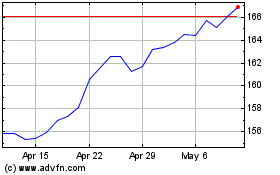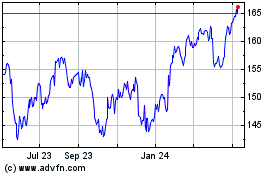Procter & Gamble's Outlook Improves -- WSJ
January 21 2017 - 3:02AM
Dow Jones News
By Sharon Terlep
Procter & Gamble Co.'s yearslong turnaround is starting to
show some results.
The maker of Gillette razors and Pampers diapers on Friday
offered a more upbeat outlook for sales growth this year as it
posted better-than-expected organic sales for the latest quarter.
The closely watched metric, which strips out currency moves,
acquisitions and divestments, increased 2% from a year earlier.
"We are essentially on track with where we hoped we would be,"
finance chief Jon Moeller said in a call with analysts. The
results, he said, were better than the company anticipated and "a
pretty good number that's representative of the general strength of
the business."
P&G shares rose 3.3% to $87.45 on Friday. The stock gained
more than 7% last year, though it lost steam in recent months as
Wall Street fretted over the pace of the company's turnaround.
P&G for years has been slashing costs and reworking how it
develops, markets and sells consumer staples as the company has
struggled to accelerate sales growth amid increased competition
from new smaller and nimbler rivals.
Progress has been slow with the company's organic sales growth
of 1%-3% in recent years stuck below prerecession levels. The
company now expects organic sales growth of 2%-3% for the fiscal
year ending in June, up from its previous 2% forecast.
P&G still faces long-term currency woes, stagnating growth
in developing markets and price wars with rivals. But the
Cincinnati giant made progress in key areas in the last three
months.
More consumers were willing to pay for high-end consumer
staples, from laundry detergent pods in the U.S. to premium
skin-care products in China. A $200 electric toothbrush, for
instance, helped deliver a surprising 7% jump in organic sales for
the company's health-care unit, which includes oral-care
products.
Sales rose in China, P&G's second-largest market and a key
area of focus for Chief Executive David Taylor since he took over
in late 2015.
Mr. Moeller said the strong U.S. dollar will be a bigger drag on
P&G's earnings than the company initially anticipated, costing
an estimated $500 million in the fiscal year ending in June. He
said P&G is resisting the urge to trim losses through currency
hedging and is instead implementing longer-term safeguards against
currency volatility, such as cost-cutting and ensuring that more
products are supplied and produced in the same markets in which
they are sold.
The latest results were the first glimpse at operations since
P&G shed the bulk of its beauty brands. P&G had long said
those brands, including CoverGirl makeup and Clairol hair dye, were
pulling resources while returning little in the way of profit or
growth. The $11.4 billion deal closed last fall, shrinking P&G
by more than 10,000 employees and 40 brands.
P&G on Friday reported fiscal second-quarter profit of $7.88
billion, or $2.88 a share, compared with year-earlier earnings of
$3.21 billion, or $1.12 a share. On an adjusted basis, which
excludes gains from the beauty sale, the company said it earned
$1.08 a share, slightly above analysts' projections for $1.06 a
share.
Sales fell 0.3% to $16.86 billion from $16.92 billion in the
year-earlier quarter.
--Joshua Jamerson contributed to this article
Write to Sharon Terlep at sharon.terlep@wsj.com
(END) Dow Jones Newswires
January 21, 2017 02:47 ET (07:47 GMT)
Copyright (c) 2017 Dow Jones & Company, Inc.
Procter and Gamble (NYSE:PG)
Historical Stock Chart
From Mar 2024 to Apr 2024

Procter and Gamble (NYSE:PG)
Historical Stock Chart
From Apr 2023 to Apr 2024
